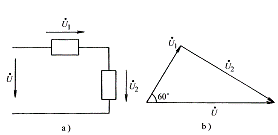The previous sections discussed the time domain relationship between voltage and current in resistors, capacitors, and inductors, as well as the corresponding phasor expressions. For simple circuits, we know that the voltage and current in the circuit are sinusoidal quantities with the same frequency as the applied excitation source. This conclusion can be extended to complex sinusoidal AC circuits in linear steady state. For complex linear circuits, if all excitation sources are sinusoidal functions of the same frequency, then the current and voltage of each branch are sinusoidal functions with the same frequency as the excitation source, and can be expressed in phasor form. The phasor calculation method can be used in circuit calculations.
The time domain expression of Kirchhoff's node current law is
![]() (3-7-1)
(3-7-1)
Because all currents are sinusoidal functions of the same frequency, the time domain summation expression can be converted into a phasor summation form according to the derivation in Section 3 of this chapter:
![]() (3-7-2)
(3-7-2)
This formula shows that for any node, the sum of the current phasors flowing out of the node is equal to zero. This is Kirchhoff's node current law in phasor form.
Kirchhoff's voltage law states that the sum of the voltage drops in any closed circuit is zero, that is,
![]() (3-7-3)
(3-7-3)
Kirchhoff's voltage law can be obtained in phasor form
![]() (3-7-4)
(3-7-4)
By making a phasor diagram of the node current or loop voltage, a closed phasor polygon can be obtained. The above two laws and phasor relationships can be used in the calculation and analysis of sinusoidal AC circuits. Here are a few examples to illustrate this.
Example 3-7-1 In the circuit of Figure 3-7-1a, we know that
,
find
the value of .
![]()
![]()
![]()
Solution: According to Kirchhoff's voltage law,
we get:
![]()
![]() The phasor diagram of voltage is shown in Figure 3-7-1b.
The phasor diagram of voltage is shown in Figure 3-7-1b.

Figure 3-7-1
Previous article:Impedance, Admittance and Equivalent Conversion of Sinusoidal AC Circuits
Next article:Capacitor elements in sinusoidal AC circuits
- Popular Resources
- Popular amplifiers
- High signal-to-noise ratio MEMS microphone drives artificial intelligence interaction
- Advantages of using a differential-to-single-ended RF amplifier in a transmit signal chain design
- ON Semiconductor CEO Appears at Munich Electronica Show and Launches Treo Platform
- ON Semiconductor Launches Industry-Leading Analog and Mixed-Signal Platform
- Analog Devices ADAQ7767-1 μModule DAQ Solution for Rapid Development of Precision Data Acquisition Systems Now Available at Mouser
- Domestic high-precision, high-speed ADC chips are on the rise
- Microcontrollers that combine Hi-Fi, intelligence and USB multi-channel features – ushering in a new era of digital audio
- Using capacitive PGA, Naxin Micro launches high-precision multi-channel 24/16-bit Δ-Σ ADC
- Fully Differential Amplifier Provides High Voltage, Low Noise Signals for Precision Data Acquisition Signal Chain
- Innolux's intelligent steer-by-wire solution makes cars smarter and safer
- 8051 MCU - Parity Check
- How to efficiently balance the sensitivity of tactile sensing interfaces
- What should I do if the servo motor shakes? What causes the servo motor to shake quickly?
- 【Brushless Motor】Analysis of three-phase BLDC motor and sharing of two popular development boards
- Midea Industrial Technology's subsidiaries Clou Electronics and Hekang New Energy jointly appeared at the Munich Battery Energy Storage Exhibition and Solar Energy Exhibition
- Guoxin Sichen | Application of ferroelectric memory PB85RS2MC in power battery management, with a capacity of 2M
- Analysis of common faults of frequency converter
- In a head-on competition with Qualcomm, what kind of cockpit products has Intel come up with?
- Dalian Rongke's all-vanadium liquid flow battery energy storage equipment industrialization project has entered the sprint stage before production
- Allegro MicroSystems Introduces Advanced Magnetic and Inductive Position Sensing Solutions at Electronica 2024
- Car key in the left hand, liveness detection radar in the right hand, UWB is imperative for cars!
- After a decade of rapid development, domestic CIS has entered the market
- Aegis Dagger Battery + Thor EM-i Super Hybrid, Geely New Energy has thrown out two "king bombs"
- A brief discussion on functional safety - fault, error, and failure
- In the smart car 2.0 cycle, these core industry chains are facing major opportunities!
- The United States and Japan are developing new batteries. CATL faces challenges? How should China's new energy battery industry respond?
- Murata launches high-precision 6-axis inertial sensor for automobiles
- Ford patents pre-charge alarm to help save costs and respond to emergencies
- New real-time microcontroller system from Texas Instruments enables smarter processing in automotive and industrial applications
- Some experience summary on AD conversion design
- How to conduct standard ZigBee testing and certification of products
- [Zero-knowledge ESP8266 tutorial] Quick Start 12- Making a flame alarm
- Ask: MOS tube switch circuit
- Introduction to the classification and manufacturing methods of PCB copper-clad laminates
- Problems that should be paid attention to in the development and design of TMS320C2XX
- Goodbye 2018, hello 2019
- STM32 related altium library files (F0, F1, F2, F3, F4, etc.)
- "Me and Intel SoC FPGA" + ARM hardcore development that is difficult to understand
- STM32L151C8T6 wake-up problem from standby mode

 LMV1012UPX-07/NOPB
LMV1012UPX-07/NOPB











 京公网安备 11010802033920号
京公网安备 11010802033920号